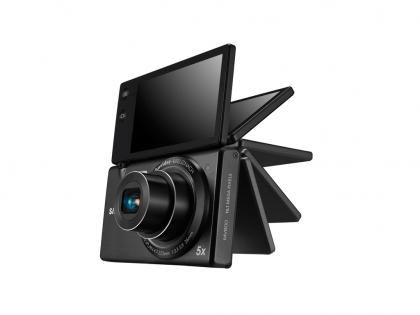Samsung's camera designers aren't afraid to innovate. Their latest creation is a stylish metal clamshell camera with a screen that rotates through 180 degrees for self-portraits. Articulated screens are hardly new but the way this one opens up like a book is certainly eye-catching. Because it's hinged at the top, it also doubles as a stand, allowing the camera to be placed on a table or other surface and tilted up at an angle. The hinged screen also makes it easy to shoot from waist height, or overhead by turning the camera upside down.

The articulated rear screen allows for many creative shooting options
Opening the screen right out for self-portraits obscures the shutter button, but Samsung has thoughtfully added another on the back of the camera. It's a natural evolution of Samsung's 2View cameras with their front- and rear-mounted screens, but the MV800's articulated screen works better because it gives a bigger screen for self-portraits.
The touchscreen controls resemble a smartphone more than a camera. A physical Home button reveals five pages of icons that present shooting modes in the style of apps. These include lots of fun features including artistic filters such as Soft Focus, Old Film and Cartoon, plus fun frames including a magazine cover, a TV and the moon. Funny Face mode uses face detection and digital distortion to skew faces, giving them big noses, alien eyes and even letting you rearrange features manually on the touchscreen. This all happens in the live preview, and will go down a storm with children. Shame it's not possible to record a Funny Face video. There's also a basic photo editor for cropping, colour correcting and applying creative filters, plus a collage maker.

…and this is meant to make me look like a professor? - click to enlarge
Smart Auto and Program modes are there too, and give a more familiar photographic experience. Here, the MV800 is unremarkable. Performance was pedestrian at 2.2 seconds between shots, rising to nine seconds with the flash at full power. Photographic settings were slow to access via the touchscreen interface, and the 0.6fps continuous mode is hardly worth bothering with.

